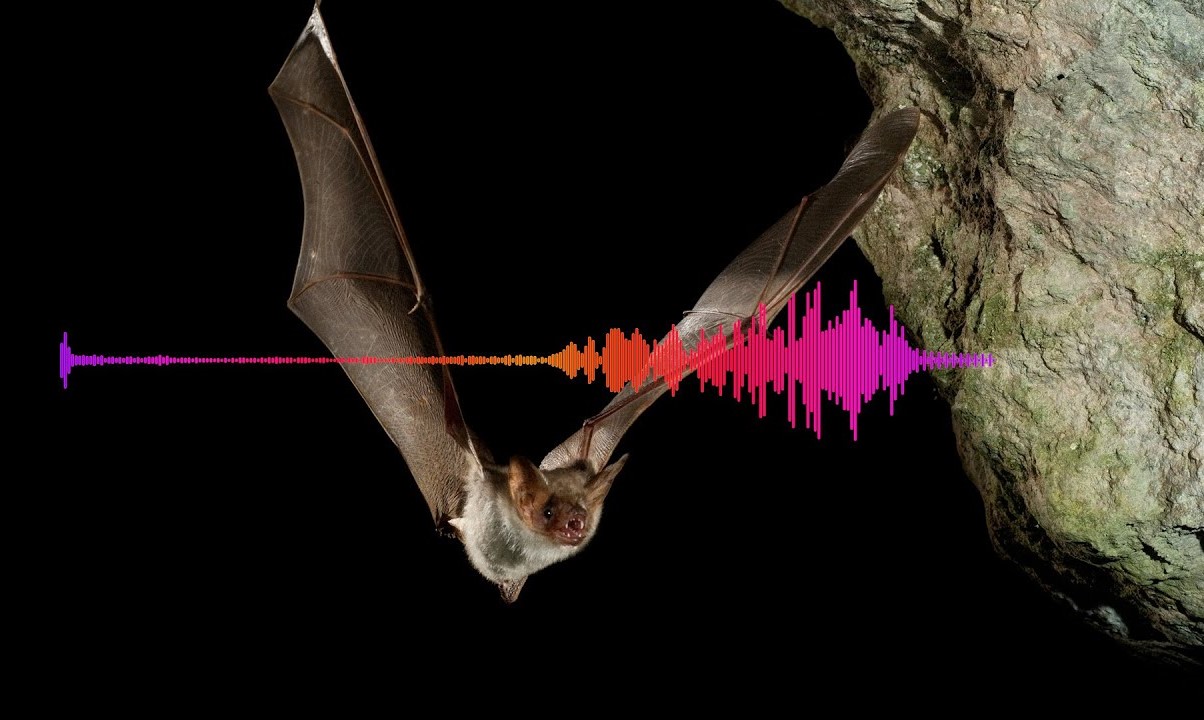

Science
Unveiling The Mysterious Sounds Of Bats
Published: January 14, 2024
Explore the fascinating world of bats and their enigmatic sounds in this captivating scientific journey. Delve into the science behind these mysterious creatures and their unique vocalizations.
(Many of the links in this article redirect to a specific reviewed product. Your purchase of these products through affiliate links helps to generate commission for Noodls.com, at no extra cost. Learn more)
Table of Contents
Introduction
Bats, often associated with darkness and mystery, are intriguing creatures that have fascinated humans for centuries. One of the most captivating aspects of bats is their unique ability to navigate and communicate using sound. This remarkable skill, known as echolocation, sets bats apart from other mammals and has captured the interest of scientists and nature enthusiasts alike.
The world of bat sounds is a fascinating realm filled with complexity and wonder. From the high-pitched clicks and chirps used for navigation to the diverse array of vocalizations for social communication, bats employ a sophisticated sonic language that remains largely enigmatic to the average person.
In this article, we will embark on a journey to unravel the enigma of bat sounds, delving into the physiology of bat echolocation, the various types of bat sounds, and the crucial role these sounds play in the daily lives of these remarkable creatures. We will also explore the methods used by researchers to study bat sounds and gain insights into the impact of human activities on these mysterious vocalizations.
Join us as we venture into the nocturnal world of bats and uncover the secrets hidden within their captivating soundscape.
Read more: How To Draw A Bat
The Physiology of Bat Echolocation
The physiology of bat echolocation is a marvel of evolutionary adaptation, enabling these nocturnal creatures to navigate and hunt in the darkness with unparalleled precision. At the heart of this extraordinary ability lies the intricate interplay between a bat's specialized anatomy and its sophisticated auditory system.
Central to the process of echolocation is the emission of high-frequency sounds, often in the form of rapid clicks or chirps, by the bat. These sounds are produced in the larynx or the nose, depending on the species, and are then emitted through the mouth or the nostrils. The emitted sounds travel through the air and, upon encountering objects in the environment, bounce back as echoes.
The bat's ears are finely tuned to detect these returning echoes, which provide crucial information about the size, shape, distance, and texture of the objects in the surrounding space. This remarkable sensory feedback allows bats to construct a detailed auditory map of their environment in real time, enabling them to navigate through cluttered and complex surroundings with astonishing accuracy.
The auditory system of bats is exquisitely adapted to process the returning echoes with exceptional sensitivity and precision. Their ears are capable of discerning minute differences in the time interval and intensity of the echoes, allowing them to construct a three-dimensional mental representation of the surrounding space. This intricate process, often likened to a bat "seeing with sound," enables these creatures to maneuver through the darkness with unparalleled agility.
Furthermore, the brains of bats are specialized to interpret and analyze the complex auditory information received from echolocation. This remarkable neural processing enables bats to make split-second decisions based on the echoes received, allowing them to swiftly alter their flight path, locate prey, and avoid obstacles with remarkable efficiency.
The physiology of bat echolocation is a testament to the astonishing adaptability and ingenuity of these remarkable creatures. Through the intricate interplay of specialized vocalization, acute auditory perception, and sophisticated neural processing, bats have honed a remarkable skill that continues to captivate and inspire scientists and nature enthusiasts worldwide.
Types of Bat Sounds
The sonic repertoire of bats encompasses a diverse array of sounds, each serving a distinct purpose in the complex tapestry of their communication and navigation. These sounds can be broadly categorized into two primary types: echolocation calls and social calls.
Echolocation Calls
Echolocation calls, also known as biosonar, form the cornerstone of a bat's navigational prowess. These high-frequency calls, typically ranging from 20 to over 100 kilohertz, are emitted by bats as they navigate through their environment. The structure and frequency of these calls vary significantly among different species, reflecting their unique ecological niches and hunting strategies.
-
Frequency Modulated (FM) Calls: Many insectivorous bats utilize FM calls, characterized by a rapid frequency sweep from high to low. This type of call allows bats to obtain detailed information about the distance and texture of objects in their surroundings, crucial for locating prey and avoiding obstacles during flight.
-
Constant Frequency (CF) Calls: Certain bat species emit CF calls, which maintain a steady frequency throughout their duration. These calls are particularly effective for detecting small, fluttering insects against a cluttered background, enabling bats to execute precise and agile pursuit maneuvers during hunting.
-
Combination Calls: Some bats employ a combination of FM and CF elements in their echolocation calls, harnessing the advantages of both strategies to optimize their hunting efficiency in diverse environments.
Social Calls
In addition to echolocation calls, bats engage in a rich repertoire of social calls to communicate with conspecifics and coordinate various aspects of their social lives. These social calls encompass a wide spectrum of vocalizations, each serving specific functions within the intricate social dynamics of bat colonies.
-
Aggression Calls: When conflicts arise within a colony, bats may emit aggressive calls to assert dominance or defend resources. These calls often exhibit distinct patterns and frequencies, signaling confrontational interactions among individuals.
-
Mating Calls: During the breeding season, male bats may produce elaborate mating calls to attract potential mates and establish their reproductive fitness. These calls can vary widely in structure and intensity, serving as a key component of courtship rituals within bat populations.
-
Maternal Calls: Mother bats emit maternal calls to communicate with their offspring, aiding in the recognition and bonding between mothers and their young. These calls play a crucial role in fostering maternal care and ensuring the survival of bat pups within the colony.
The diverse array of bat sounds, encompassing both echolocation calls and social vocalizations, reflects the remarkable adaptability and complexity of bat communication. By harnessing the power of sound, bats have evolved an intricate sonic language that underpins their survival and social cohesion in the dynamic ecosystems they inhabit.
The Role of Bat Sounds in Navigation
The role of bat sounds in navigation is a testament to the remarkable adaptability and precision of these nocturnal creatures. Echolocation, the process through which bats emit high-frequency sounds and interpret the returning echoes to navigate their surroundings, lies at the heart of their extraordinary navigational prowess. This sophisticated form of sonar allows bats to perceive their environment in intricate detail, enabling them to maneuver through cluttered and complex spaces with astonishing accuracy.
When a bat emits an echolocation call, the sound waves travel through the air and bounce off objects in the surrounding environment. The returning echoes carry vital information about the distance, size, shape, and texture of these objects. By analyzing the temporal and spectral features of the echoes, bats construct a detailed mental map of their surroundings, effectively "seeing" with sound.
The remarkable precision of bat echolocation is exemplified by their ability to detect and intercept small, agile prey such as insects in mid-flight. By emitting rapid sequences of echolocation calls and analyzing the subtle changes in the returning echoes, bats can pinpoint the exact location of their prey and execute lightning-fast pursuit maneuvers with unparalleled accuracy.
Furthermore, the adaptability of bat echolocation is evident in the diverse strategies employed by different bat species. From frequency-modulated calls that provide detailed information about the texture of objects to constant frequency calls optimized for detecting small, fluttering insects, bats have honed their echolocation abilities to suit their specific ecological niches and hunting strategies.
The role of bat sounds in navigation extends beyond individual foraging behavior, encompassing the collective dynamics of bat colonies. In the darkness of night, bats navigate through complex habitats while maintaining spatial awareness and avoiding collisions with fellow colony members. Their echolocation calls not only aid in individual navigation but also contribute to the overall coordination and cohesion of bat colonies, ensuring seamless flight patterns and spatial organization within roosting sites.
The intricate interplay between echolocation calls and the auditory perception of returning echoes underscores the pivotal role of bat sounds in facilitating their remarkable navigational feats. By harnessing the power of sound to construct a detailed auditory map of their environment, bats have unlocked the secrets of nocturnal navigation, showcasing the awe-inspiring adaptability and ingenuity of these enigmatic creatures.
Studying Bat Sounds
Studying bat sounds presents a captivating journey into the realm of acoustic ecology, where scientists employ a diverse array of innovative techniques to unravel the mysteries concealed within the sonic world of bats. The multifaceted nature of bat sounds, encompassing both echolocation calls and social vocalizations, has spurred the development of specialized methodologies aimed at capturing, analyzing, and interpreting these enigmatic vocalizations.
One of the primary methods used in studying bat sounds involves the deployment of ultrasonic recording devices, commonly known as bat detectors. These sophisticated instruments are equipped with ultrasonic microphones capable of capturing the high-frequency calls emitted by bats during echolocation and social communication. By strategically placing bat detectors in diverse habitats, researchers can gather valuable data on the acoustic behavior of bats, shedding light on their foraging activities, social interactions, and navigational strategies.
In addition to passive acoustic monitoring, researchers also utilize advanced technologies such as acoustic identification software to analyze the intricate patterns and frequencies present in bat calls. This cutting-edge software enables the automated identification and classification of bat species based on their unique echolocation signatures, providing valuable insights into species diversity and distribution within specific ecosystems.
Furthermore, studies on bat sounds often involve the use of high-speed infrared cameras and motion-sensing equipment to visualize the flight patterns and hunting behaviors of bats in conjunction with their echolocation calls. By integrating visual data with acoustic recordings, researchers can gain a comprehensive understanding of how bats utilize sound to navigate, locate prey, and interact within their natural habitats.
Moreover, the emerging field of citizen science has played a pivotal role in expanding the scope of bat sound research. Enthusiastic volunteers, equipped with bat detectors and recording devices, actively contribute to acoustic surveys and monitoring efforts, significantly enhancing the breadth and depth of data collected on bat vocalizations across diverse geographical regions.
The study of bat sounds transcends conventional disciplinary boundaries, encompassing elements of biology, ecology, acoustics, and technology. By harnessing a multidisciplinary approach, researchers continue to unravel the intricate complexities of bat sounds, shedding light on the ecological significance of these vocalizations and their vulnerability to environmental changes.
The ongoing exploration of bat sounds serves as a testament to the enduring allure and scientific importance of these enigmatic vocalizations, inspiring a new generation of researchers to delve into the captivating world of bat acoustics and contribute to the conservation and understanding of these remarkable creatures.
The Impact of Human Activities on Bat Sounds
Human activities have exerted profound effects on the acoustic landscape of bat habitats, posing significant challenges to the communication, navigation, and survival of these remarkable creatures. The encroachment of human infrastructure, the proliferation of anthropogenic noise, and the widespread use of pesticides have collectively reshaped the acoustic environments in which bats reside, triggering a range of detrimental impacts on their vocalizations and echolocation behaviors.
One of the most pervasive threats to bat sounds arises from the rapid expansion of urbanization and industrial development. As human settlements encroach upon natural habitats, bats are increasingly exposed to elevated levels of ambient noise generated by vehicular traffic, industrial machinery, and urban infrastructure. This anthropogenic noise pollution can interfere with the intricate echolocation calls of bats, disrupting their ability to accurately perceive and interpret returning echoes. Consequently, bats may encounter challenges in navigating through cluttered urban landscapes and locating prey amidst the cacophony of human-generated sounds.
Furthermore, the widespread use of pesticides and agrochemicals in agricultural practices has raised concerns regarding the potential impact on bat vocalizations and foraging behaviors. Certain pesticides, particularly those belonging to the class of neonicotinoids, have been implicated in causing neurobehavioral alterations in bats, potentially affecting their echolocation abilities and hunting success. The disruption of bat vocalizations due to pesticide exposure can have cascading effects on ecosystem dynamics, influencing the population dynamics of insect prey and the ecological balance within bat habitats.
In addition to direct acoustic disturbances, human activities have led to the alteration and fragmentation of bat habitats, further exacerbating the impact on bat sounds. The destruction of roosting sites, deforestation, and habitat loss driven by human intervention have disrupted the natural acoustic environments crucial for bat communication and navigation. These habitat modifications can impede the transmission and reception of bat vocalizations, posing challenges to the social cohesion and reproductive behaviors of bat colonies.
The cumulative impact of human activities on bat sounds underscores the urgent need for conservation efforts aimed at mitigating these detrimental effects. By implementing measures to reduce anthropogenic noise pollution, preserve and restore bat habitats, and promote sustainable agricultural practices, we can strive to safeguard the intricate sonic world of bats and ensure the preservation of their vital vocalizations for generations to come.
The ongoing exploration of bat sounds serves as a testament to the enduring allure and scientific importance of these enigmatic vocalizations, inspiring a new generation of researchers to delve into the captivating world of bat acoustics and contribute to the conservation and understanding of these remarkable creatures.
Conclusion
In conclusion, the enigmatic sounds of bats represent a captivating symphony of evolutionary adaptation, ecological significance, and the enduring resilience of these remarkable creatures. From the intricate physiology of bat echolocation to the diverse array of echolocation and social calls, the sonic world of bats offers a glimpse into the awe-inspiring complexity of their communication and navigation.
The physiology of bat echolocation stands as a testament to the remarkable adaptability and ingenuity of these nocturnal creatures. Through the intricate interplay of specialized vocalization, acute auditory perception, and sophisticated neural processing, bats have honed a remarkable skill that continues to captivate and inspire scientists and nature enthusiasts worldwide.
The diverse array of bat sounds, encompassing both echolocation calls and social vocalizations, reflects the remarkable adaptability and complexity of bat communication. By harnessing the power of sound, bats have evolved an intricate sonic language that underpins their survival and social cohesion in the dynamic ecosystems they inhabit.
The role of bat sounds in navigation underscores the pivotal role of these vocalizations in facilitating the remarkable navigational feats of bats. By harnessing the power of sound to construct a detailed auditory map of their environment, bats have unlocked the secrets of nocturnal navigation, showcasing the awe-inspiring adaptability and ingenuity of these enigmatic creatures.
Studying bat sounds presents a captivating journey into the realm of acoustic ecology, where scientists employ a diverse array of innovative techniques to unravel the mysteries concealed within the sonic world of bats. The ongoing exploration of bat sounds serves as a testament to the enduring allure and scientific importance of these enigmatic vocalizations, inspiring a new generation of researchers to delve into the captivating world of bat acoustics and contribute to the conservation and understanding of these remarkable creatures.
The impact of human activities on bat sounds underscores the urgent need for conservation efforts aimed at mitigating these detrimental effects. By implementing measures to reduce anthropogenic noise pollution, preserve and restore bat habitats, and promote sustainable agricultural practices, we can strive to safeguard the intricate sonic world of bats and ensure the preservation of their vital vocalizations for generations to come.
In essence, the study of bat sounds unveils a world of mystery, complexity, and ecological significance, inviting us to appreciate the profound role of sound in the lives of these extraordinary creatures. As we continue to unravel the secrets concealed within the enigmatic sounds of bats, we embark on a journey of discovery that enriches our understanding of the natural world and underscores the imperative of preserving the intricate sonic tapestry of bat habitats.














